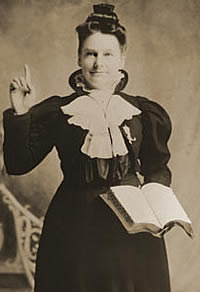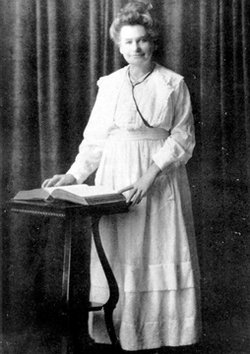 In our continuing survey of nineteenth century American women evangelists we must not leave out Maria Woodworth Etter – The Grandmother of the Pentecostal Movement.
In our continuing survey of nineteenth century American women evangelists we must not leave out Maria Woodworth Etter – The Grandmother of the Pentecostal Movement.
Maria was born to Samuel and Matilda Underwood on July 22, 1844 in Lisbon Ohio. Her parents were not religious which Maria deeply regretted. When she was twelve years old her father died of a severe case of sunstroke. Maria and her sister dropped out of school to help their mother raise the eight children in her family.
Maria desperately wanted to get an education. She had to content herself with reading her books in her kitchen. She would memorize Bible verses as she worked.
When she was thirteen years old Maria went to a Disciples of Christ church meeting. There she gave her heart to the Lord. At this time she also felt her initial call to evangelism. She did not understand this because, as she later related in her autobiography, the Disciples “did not believe that women had any right to work for Jesus. Had I told them my impression they would have made sport of me. I had never heard of women working in public except as missionaries, so I could see no openings – except, as I thought, if I ever married…”
A few years later she married Philo Harris Woodworth. Maria had six children, but five of them died while they were young. These deaths led to constant illness for Maria. During her long periods of convalescence she often had dreams of evangelizing. At one point when she was on the brink of death she promised God that if He would restore her to health she would then commit herself to the evangelistic work that He had called her to so many years before. At that moment she felt herself recovering from her illness. She then began to wonder how she could work for God by telling others about Jesus.
Not long after this her only remaining son Willie died leaving Maria and Philo with a single child, a teenage daughter, Elizabeth (Lizzie). Maria believed that all of these trials were preparation for her evangelistic ministry. Her acquaintance with grief and sorrow would give her the compassion she would need for lost sinners.
Other ministers began to encourage her to start her ministry. At first she was not sure. She said, “If I were a man I would love to work for Jesus.” These ministers assured her that she had work to do and that she should not be stopped because of her gender. Her husband Philo was not enthusiastic about her being an itinerant evangelist so she sought an opportunity to speak locally.
Maria got her first opportunity at a Friends’ meeting. When she got up to speak she was struck with a vision of hell and the danger for people who did not know their peril of damnation. She began to call for them to repent and follow God and be saved. Many cried out in repentance and came forward to receive Christ.
Wishing to obey her husband Maria held evangelistic meetings in nearby churches and communities. She received offers from several denominations to pastor one of their churches. These were local churches and the pay was good, but Maria was still determined to follow her call as an itinerant evangelist. She wanted to go wherever the Lord would lead her. When the farm failed, Maria and Philo moved to the Midwest.
Maria felt that God was urging her to pray for healing for people. She also believed that she had “the gift of healing, and of laying on of hands for the recovery of the sick.” She reported in her autobiography the stories of many hundreds of people who were healed and subsequently saved.
The numbers of people at her evangelistic meetings began to grow. Philo had agreed to accompany her but he soon began to cause trouble. He was making money on the side, which caused the media to ridicule her. He was also unfaithful in their marriage. Maria sued for divorce on the grounds of repeated adultery and divorce was granted in 1891. Philo died a little over a year later of typhoid fever.
A little over ten years later Maria married Samuel Etter. Samuel was the opposite of Philo. Maria said, “He takes the best care of me, in and out of the meetings. … He will pray and preach, and sing, and is very good around the altar…. The Lord knew what I needed and it was brought about by the Lord, through his love and care for me and the work.” They were happily married for twelve years. Samuel died in1914.
Parts of Maria’s ministry were controversial. Many did not believe that the miracles of healing were really happening at her meetings. Some believed that Maria was just being dramatic; some accused her of being a charlatan. But it is well documented that many thousands came forward and received spiritual and physical healing. While Maria faced some opposition for this, it was no more than any modern “healing evangelist” would encounter. There are doubters in every age.
A major controversy was the trances that Maria would fall into while preaching. She was sometimes in a rigid condition for 45 minutes to several hours. She could stand a long time with her face lifted skyward silently praying with tears streaming down her face over and over again for God to give repentance and salvation to the people. Maria’s trances were the subject of much debate and it was never determined for sure if they were genuine or not, but they sure drew the crowds. By the summer of 1885 the stories of her trances were well known. Maria had to increase the size of her gospel tents to accommodate the multitudes of people who would come from many miles away to hear her.
Maria enjoyed acclamation from many ministers of many different denominations.  Though she was originally reluctant to speak in public because she was a woman her call to evangelistic work was unmistakable. After having a further experience of dedication of her life to God she put her complete trust in Him. She was willing to go and speak the words that God would give her. Day and night her one desire was to preach repentance and forgiveness of sins and the story of the cross.
Though she was originally reluctant to speak in public because she was a woman her call to evangelistic work was unmistakable. After having a further experience of dedication of her life to God she put her complete trust in Him. She was willing to go and speak the words that God would give her. Day and night her one desire was to preach repentance and forgiveness of sins and the story of the cross.
Maria has been called the Grandmother of the Pentecostal Movement. Thanks to her courage in following her call many received the witness of Christ. Many have been convicted of the power of the Holy Spirit. She did much to advance the role of women in ministry. Maria had a great influence on Aimee Semple McPherson, John G. Lake, F.F. Bosworth, and Kathryn Kuhlman.
For the last six years of her life from 1918 to her death in 1924 Maria worked at the church that she founded in Indianapolis. She used it as her headquarters and traveled from there to minister throughout the Midwest. This church stands today as a conference center known as Lakeview Christian Center.
She continued to speak up to her very last days. As she grew weaker she was carried to the pulpit in a chair. Finally she ministered from her bed, faithful to her calling to the end. On September 16, 1924 Maria fell into a deep sleep and went to the arms of her Savior at the age of eighty still proclaiming God’s love. Truly the epitaph on her grave reflects her life – “Thou showest unto thousands lovingkindness.”

